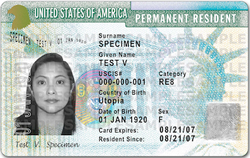 There are four types of immigration through which a person obtains a green card and becomes a legal immigrant, or LPR:
There are four types of immigration through which a person obtains a green card and becomes a legal immigrant, or LPR:
1. Family-based
A U.S. citizen may sponsor his or her spouse, parent (if the sponsor is 21 or older), children, brothers and sisters. An LPR may sponsor his or her spouse, minor children and adult unmarried children. Sponsors must have an income level that exceeds nationally established poverty guidelines by 25% and must promise in writing to support the family member(s) he or she wishes to sponsor. Although, there is an annual limit on the family-based immigrants, there is no limit to the number of visas available to:
1. Spouses of U.S. citizens
2. Unmarried minor children of U.S. citizens (includes stepchildren under some circumstances)
3. Parents of U.S. citizens (These three types are called “immediate relatives”)
For family-based immigrants who are not immediate relatives, there is a Family Preference System that limits the number of immigrant visas to different foreign nationals. Backlogs in the quotas are common. For more accurate information regarding visa availability, see the most recent issue of the Visa Bulletin for current dates.
2. Employment-based
Through the Labor Certification Process as well as through several methods for exceptional foreign nationals, including National Interest Waivers, employers can sponsor a foreign national for admission as an LPR. The process usually involves demonstrating to the Department of Labor that there are no available U.S. workers for the job for which an immigrant visa is sought. The number of employment-based visas available each fiscal year is limited to 140,000. There are five types of employment-based immigrant visas, and they are ranked by priority of the needs of the U.S. economy and employers as well as the immigrant’s education and skill level.
3. Refugees/Asylees
Refugees are foreign nationals located outside the U.S. who want to enter the U.S. to escape persecution in his or her home country. An Asylee is a foreign national who is already in the U.S. that wants to remain because he or she fears persecution in his or her home country.
Refugee and Asylum applicants must prove that they have a well-founded fear of persecution based on one of the following recognized grounds:
- Race
- Religion
- Membership in a social group
- Political opinion
- National origin
There is no limitation on the number of persons who may be granted asylum in a given fiscal year. Limitations on the number of refugees admitted annually are determined by the President and are divided up by world regions. Further, only 10,000 asylees may become LPRs in any fiscal year, while no limit is placed on refugees.
4. Diversity Lottery Visa
Each year, the Diversity Lottery Program makes 50,000 new immigrant visas available for individuals from underrepresented nations. Administered by the U.S. State Department, the Diversity Lottery Program requires that you have either a high school education, its equivalent, or two years work experience within the last five years in a job which demands two years training. You or your spouse must be a native of a nation eligible for the Diversity Lottery Program.
Serving Southwest Ohio clients in Cincinnati, Mason, Lebanon, West Chester, Montgomery, Hamilton, Middletown, Batavia, Wilmington and surrounding areas.
Warren County • Butler County • Hamilton County • Clermont County • Clinton County
